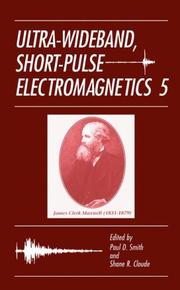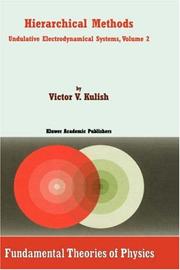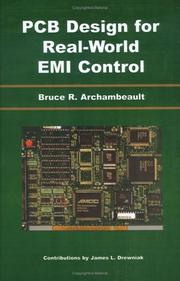| Listing 1 - 4 of 4 |
Sort by
|

ISBN: 0306479486 0306473380 Year: 2002 Publisher: New York : Kluwer Academic Publishers,
Abstract | Keywords | Export | Availability | Bookmark
 Loading...
Loading...Choose an application
- Reference Manager
- EndNote
- RefWorks (Direct export to RefWorks)
The fifth Conference on Ultra-Wideband Short-Pulse Electromagnetics was held in Scotland from 30 May to 2 June 2000 at the Edinburgh International Conference Centre. It formed part of the EUROEM 2000 International Conference under the chairmanship of David Parkes (DERA, Malvern) and Paul Smith (University of Dundee). It continued the series of international conferences that were held first at the Polytechnic University, Brooklyn, New York in 1992 and 1994, then in Albuquerque, New Mexico in 1996 (as part of AMEREM ’96) and more recently in Tel-Aviv, Israel in 1998 (as part of EUROEM ’98). The purpose of these meetings is to focus on advanced technologies for the generation, radiation and detection of ultra-wideband short pulse signals, taking into account their propagation, scattering from and coupling to targets of interest; to report on developments in supporting mathematical and numerical methods; and to describe current and potential future applications of the technology.
Radar --- Ultra-wideband devices --- Signal processing --- Telecommunication. --- Computer engineering. --- Microwaves. --- Mathematics. --- Communications Engineering, Networks. --- Electrical Engineering. --- Theoretical, Mathematical and Computational Physics. --- Microwaves, RF and Optical Engineering. --- Applications of Mathematics. --- Electrical engineering. --- Mathematical physics. --- Optical engineering. --- Applied mathematics. --- Engineering mathematics. --- Engineering --- Engineering analysis --- Mathematical analysis --- Mechanical engineering --- Hertzian waves --- Electric waves --- Electromagnetic waves --- Geomagnetic micropulsations --- Radio waves --- Shortwave radio --- Physical mathematics --- Physics --- Electric engineering --- Mathematics --- Ultra-wideband radar

ISBN: 0306480611 1402007574 Year: 2002 Publisher: Dordrecht, Netherlands : Kluwer Academic Publishers,
Abstract | Keywords | Export | Availability | Bookmark
 Loading...
Loading...Choose an application
- Reference Manager
- EndNote
- RefWorks (Direct export to RefWorks)
Everybody is current in a world surrounded by computer. Computers determine our professional activity and penetrate increasingly deeper into our everyday life. Therein we also need increasingly refined c- puter technology. Sometimes we think that the next generation of c- puter will satisfy all our dreams, giving us hope that most of our urgent problems will be solved very soon. However, the future comes and il- sions dissipate. This phenomenon occurs and vanishes sporadically, and, possibly, is a fundamental law of our life. Experience shows that indeed ‘systematically remaining’ problems are mainly of a complex tech- logical nature (the creation of new generation of especially perfect - croschemes, elements of memory, etc. ). But let us note that amongst these problems there are always ones solved by our purely intellectual efforts alone. Progress in this direction does not require the invention of any ‘superchip’ or other similar elements. It is important to note that the results obtained in this way very often turn out to be more significant than the ‘fruits’ of relevant technological progress. The hierarchical asymptotic analytical–numerical methods can be - garded as results of such ‘purely intellectual efforts’. Their application allows us to simplify essentially computer calculational procedures and, consequently, to reduce the calculational time required. It is obvious that this circumstance is very attractive to any computer user.
Physics. --- Applied mathematics. --- Engineering mathematics. --- Computer mathematics. --- Microwaves. --- Optical engineering. --- Theoretical, Mathematical and Computational Physics. --- Computational Mathematics and Numerical Analysis. --- Applications of Mathematics. --- Microwaves, RF and Optical Engineering. --- Mechanical engineering --- Hertzian waves --- Electric waves --- Electromagnetic waves --- Geomagnetic micropulsations --- Radio waves --- Shortwave radio --- Computer mathematics --- Discrete mathematics --- Electronic data processing --- Engineering --- Engineering analysis --- Mathematical analysis --- Natural philosophy --- Philosophy, Natural --- Physical sciences --- Dynamics --- Mathematics --- Mathematical physics. --- Physical mathematics --- Physics --- Electrodynamics --- Asymptotic expansions. --- Mathematics. --- Asymptotic developments --- Asymptotes --- Convergence --- Difference equations --- Divergent series --- Functions --- Numerical analysis

ISBN: 030648062X 1402009682 Year: 2002 Publisher: Dordrecht, Netherlands ; Boston, Massachusetts : Kluwer Academic Publishers,
Abstract | Keywords | Export | Availability | Bookmark
 Loading...
Loading...Choose an application
- Reference Manager
- EndNote
- RefWorks (Direct export to RefWorks)
The book consists of two Volumes. The first (the preceding volume) is devoted to the general nonlinear theory of the hierarchical dynamic oscillative–wave systems. This theory has been called the theory of hi- archical oscillations and waves. Here two aspects of the proposed theory are discussed. The first aspects concern the fundamental nature and the basic c- cepts and ideas of a new hierarchical approach to studying hierarchical dynamic systems. A new hierarchical paradigm is proposed as a - sis of a new point of view of such types of systems. In turn, a set of hierarchical principles is formulated as the fundamental basis of this paradigm. Therein the self-resemblance (holographic) principle plays a key role here. An adequate mathematic description (factorization) of the proposed paradigm is carried out. The concepts of structural and dynamic (functional) operators are put into the basis of this descr- tion. Electrodynamics is chosen as a convenient basis for an obvious demonstration of some key points of the proposed new theory. The second aspect has a purely mathematical nature. It is related to the form of factorization (i.e., mathematical description) of hier- chical types of dynamic models, and discussion of the methods of their mathematical analysis. A set of the hierarchical asymptotic analytical– numerical methods is given as an evidence of the practical effectiveness of the proposed version of hierarchical theory.
Physics. --- Applied mathematics. --- Engineering mathematics. --- Electrical engineering. --- Microwaves. --- Optical engineering. --- Theoretical, Mathematical and Computational Physics. --- Electrical Engineering. --- Applications of Mathematics. --- Microwaves, RF and Optical Engineering. --- Mechanical engineering --- Hertzian waves --- Electric waves --- Electromagnetic waves --- Geomagnetic micropulsations --- Radio waves --- Shortwave radio --- Electric engineering --- Engineering --- Engineering analysis --- Mathematical analysis --- Natural philosophy --- Philosophy, Natural --- Physical sciences --- Dynamics --- Mathematics --- Mathematical physics. --- Physical mathematics --- Physics --- Electrodynamics --- Asymptotic expansions. --- Mathematics. --- Asymptotic developments --- Asymptotes --- Convergence --- Difference equations --- Divergent series --- Functions --- Numerical analysis

ISBN: 1402071302 9781402071300 1475736428 1475736401 Year: 2002 Volume: [SECS 696] Publisher: Boston : Kluwer,
Abstract | Keywords | Export | Availability | Bookmark
 Loading...
Loading...Choose an application
- Reference Manager
- EndNote
- RefWorks (Direct export to RefWorks)
This book emphasizes understanding basic concepts of controlling the currents on printed circuit boards (pcb's), and provides a wealth of insightful information detailing the possible sources of emissions. Numerous design strategies are presented to help readers understand how to produce, control and eliminate emission sources. Additional highlights include the following: information explaining how to design pcb's to pass EMC Requirements the first time! controlling intentional and unintentional currents at their source; decoupling strategies explained and myths exposed; proper I/O filter design and connection strategy explained; not simply a list of do's and don't's...but an explanation of "why" things work as they do; -"Ground is a place where potatoes and carrots grow!" -Basic shielding design considerations for PCBs included, and more. This 'hands-on' book will help designers understand "why" or "why not" to implement a specific design practice.
Printed circuits --- Electromagnetic interference --- Circuits imprimés --- Design and construction --- Prevention --- Conception et construction --- Elektromagnetische interferentie --- Gedrukte schakelingen --- Elektromagnetische interferentie. --- Gedrukte schakelingen. --- Circuits imprimés --- Electronic circuits. --- Electrical engineering. --- Microwaves. --- Optical engineering. --- Circuits and Systems. --- Electrical Engineering. --- Microwaves, RF and Optical Engineering. --- Mechanical engineering --- Electron-tube circuits --- Electric circuits --- Electron tubes --- Electronics --- Hertzian waves --- Electric waves --- Electromagnetic waves --- Geomagnetic micropulsations --- Radio waves --- Shortwave radio --- Electric engineering --- Engineering --- Printed circuits - Design and construction --- Electromagnetic interference - Prevention --- Interference, Electromagnetic --- Electric interference --- Electromagnetic compatibility --- Electromagnetic noise --- Signal integrity (Electronics)
| Listing 1 - 4 of 4 |
Sort by
|

 Search
Search Feedback
Feedback About UniCat
About UniCat  Help
Help News
News